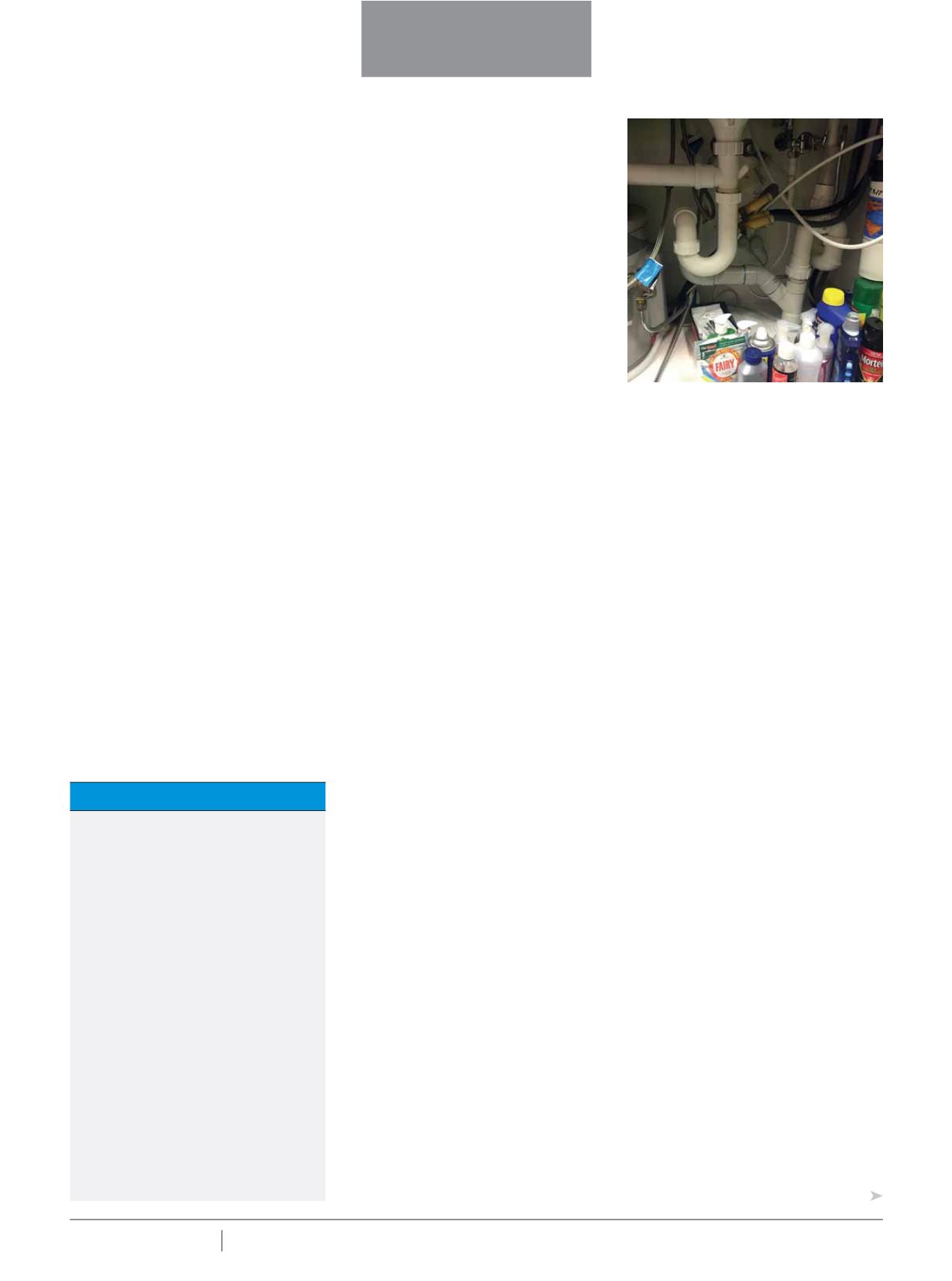

2 0
PLUMBING CONNECTION Summer 2017
Other than poor quality, the majority
of these reasons are not due to the
connector itself, which suggests the
issue of bursting flexible hoses is largely
preventable.
INSTALLATION
Russell and Trevor both suggested
installation issues are playing a big
role in bursting flexible braided hoses,
particularly in regards to the tightening of
the nuts at either end of the connectors.
“Where the nut is connected at one end
under the sink or to the mains water its
fine but when it comes to tightening up
the second nut, which connects to the tap
assembly, the design is such that the first
nut can become loose,” says Trevor.
“When you tighten the first nut, the
second nut can actually partially loosen
off again if the ferrule isn’t gripped or
held at the first end.”
This slight loosening leads to a slow
leak that allows water to migrate across
the rubber seal face down to the back
face of the nut and eventually onto the
braiding.
Tightening the nuts is also an issue
where the installing plumber hasn’t
torqued one or both of the nuts
sufficiently. If it’s too loose it creates a
leak path and if it’s too tight the seal will
rupture.
“These end in the same result, which
is corrosion of the stainless steel
braiding, leading to wire breakage and
then the rubber tube expanding and
bursting,” says Trevor.
The rise of the DIY culture in Australia
and the low cost of these connectors
are also increasing the likelihood of
flexible hose failures, as they encourage
handymen to attempt installations
themselves.
General insurer Budget Direct says on
its website that this is compromising
the integrity of flexi hoses in homes as
DIY is more likely to result in flexible
hoses being damaged at the time of
installation, which then increases the
chance of bursting.
There are fears that eventually
insurance companies will begin
disallowing claims if customers can’t
prove installation by a licensed plumber
as well as regular maintenance.
“There’s a significant risk here for
the home owner and it’s likely to get
far worse given the high rate of losses
insurers are currently reporting due
to these flexible connectors,” says
Metropolis chartered loss adjuster
director David Pockett.
EFFECTS OF WATER HAMMER
Although by itself water hammer will
not cause failure, it is a contributing
factor that can play a role in the final
catastrophic failure of a flexible braided
hose once it has been brought to a
vulnerable point.
Phillip Woolhouse has more than 30
years experience in the plumbing sector
and is the principal consultant at Phil
Woolhouse Hydraulics in Perth. He says
the speed at which modern tapware can
be isolated puts the rubber seal under
constant force.
“Mixer taps can be closed in a fraction
of a second and the faster the tap is
isolated, the higher the pressure shock.
Pressure well above 500kpa can be
experienced by modern fast-closing
tapware and this generates massive
shock pressures within the piping
system.”
According to Trevor, this can cause
the rubber seal to react by compressing
over time and forming a permanent
stress.
“Some rubber does have a memory
effect and will shrink. Over time this
loosens the nut and there’s less contact
pressure on the seal face, allowing
water to leak.”
QUALITY OF MATERIALS
With the price of flexible braided
hoses continuing to drop and a number
of new products entering the market,
there are concerns that the quality of
steel and brass components being used
in some hoses are contributing to the
early failures being seen in the field.
Trevor says he has come across
flexible braided hoses where the
brass barb fittings were not properly
manufactured or heat treated.
“Alpha-beta brass had been used,
which is cheaper but more susceptible
to de-zincification corrosion, and had
not been carefully controlled during
the manufacturing and thermal cycling
process. The aim is to produce a
microstructure with ‘islands’ of beta
phase but when they interconnect,
forming a continuous network, once
corrosion occurs it creates a continuous
pathway allowing water to pass through
the cross-section of the barb fitting
from the inside to the outside surface.
The water is then in direct contact with
the area where the rubber tube of the
hose and the stainless steel braiding are
crimped.”
COVER STORY
FLEXIBLE BRAIDED HOSES
CONSIDERATIONS FOR PLUMBERS
Below are five key considerations for
plumbers when specifying and installing
flexible hoses from attendees at the
Plumbing Connection
flexible hose workshop.
1. Ensure you purchase the correct length of
hose for the installation. It’s better for the
hose to be too long rather than too short
as this allows the hose more space and
reduces stress on the connections.
2. Ensure the connections are firm and leak
free.
3. Offer to routinely inspect flexible
connectors as part of a regular
maintenance in all premises that you visit.
4. Be prepared to pay slightly extra for
a quality connector from a reputable
supplier that offers a credible warranty.
5. If you become involved in a flexible hose
failure, photograph the hose in detail and
in situ with context photos. Retain the
photos securely and the hose in a sealed
bag as evidence with clear labeling. Only
release this item directly to an independent
material testing expert who signs for it.
Common household cleaners stored
under kitchen or bathroom sinks where
flexible braided hoses are installed can
create fume cupboard environments
that corrode the braided stainless steel
sleeve, leading to bursting hoses.
















